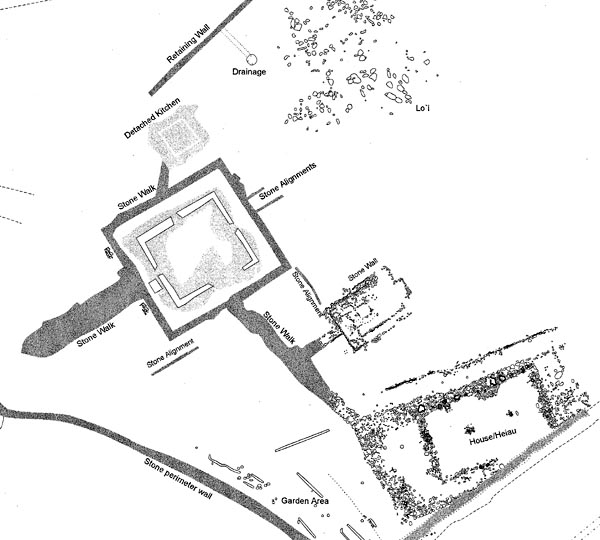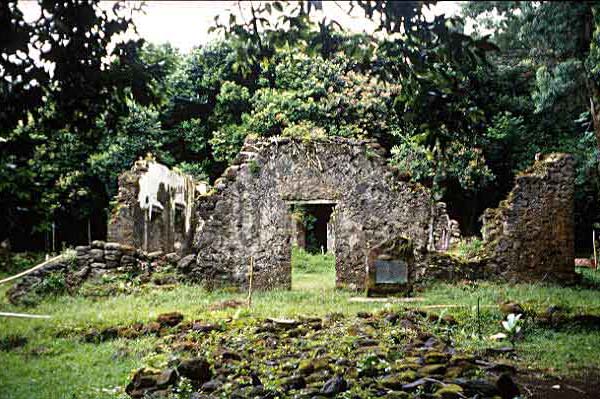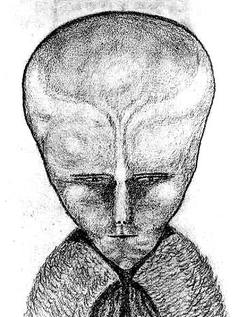This is the summer residence of Kamehameha III, in Nuuanu, about a mile from our house:

 Nu’uanu, O’ahu – A Native Place: Kaniakapupu
Nu’uanu, O’ahu – A Native Place: Kaniakapupu
"Ruins of the summer palace as seen from the top of the heiau site… The Heiau o Kaniakapupu (“Temple of the sounding land shells”) in particular occupied such a strategic position. Charles Kenn (n.d.) wrote, “People coming to Honolulu from the other side of the island were obliged to pay tithes to the priests of the temple, in return for which they received comfort and medical attention.”
“Besides administering to the weary, temples dedicated to Lono were bulwarks of defense during emergencies.”
In the site map above, you can see that the King Kamehameha III’s heiau for the human sacrifices to Lono is positioned directly on the stream. That’s to get the Death energy from those sacrifices into the water, to carry it out, to suffuse it throughout the wider environment.
You can also see how the site is surrounded by a stone wall.
The apologist caption on the picture of the stone human sacrifice platform says “house/heiau”, when it had nothing to do with, er, “housing”.
The words “mystery”, “baffled” and “puzzled” are memes, used, among numerous similar variants, whenever anyone in the wholly-controlled-and-coopted Political, Academic, Scientific and Media establishments wants to lie about, well, basically anything. That’s why the article goes on to say “The nature and extent of this heiau complex is not truly known .”
To this day, you’re also not allowed to go visit the site, and a protective fence has now been put up around it. That’s because it is brim-full of evidence documenting human sacrifice and cannibalism.
The article goes on to say “Though all of Luakaha – encompassing the entire top third of Nu‘uanu – was Crown land belonging to the king, the results of the Mahele would carve it up, and a private property called “Luakaha” would quickly take shape just below Kaniakapupu. This luxurious area has been the home of missionary families since the mid 19th century.”
With those “luxury-seeking” missionary families being the new heads of the Black-magic crime family, working the same Earth-energy magick that Kamehameha III had before them.
To this day, the Nuuanu valley is lined almost exclusively with churches of every last religion you can name, from every nation. You remember St. Peter’s in Rome being built directly on top of an ancient place of Cybele worship, right?
Same Illuminist shit, different day, I’m afraid.
The words “mystery”, “baffled” and “puzzled” are memes, used, among numerous similar variants, whenever anyone in the wholly-controlled-and-coopted Political, Academic, Scientific and Media establishments wants to lie about, well, basically anything. One of those many variants is “uncertain”. That’s why the article goes on to say "The extensiveness of the heiau site, then, is uncertain. Lynette states, “If this is truly a heiau site, it doesn’t stand all by itself. There are pieces connected to it everywhere, and we should look at a larger view.”
Where it is implied that it might not even be a true heiau site, at all.
Can you see how there is no description of what, specifically, a heiau evenis?To get a better idea, let’s take a quick look at Mo’okini Heiau at Pu’uepa, North Kohala District, on the Big Island of Hawai’i, the birthplace of Kamehameha I, built in A.D. 460:
"It represents a classic example of the walled type. A large stone called Pohakuhanauali’i, the afterbirth of Kamehamhema is located near this heiau.
[image]
(Mo’okini Heiau at Pu’uepa, Big Island)
Human sacrifice was routinely practiced here, taking the mana (spiritual strength) from the victim to insure victory in war. The captives, usually chiefs captured in battle, would be hung upside down on wooden racks, where their sweat would be collected to anoint the Kahuna (priests). Next the victims would have their bones and flesh pounded to soften the meat. The victims would then be disembowled and either cooked or eaten raw by the Kahuna and the Ali’i (Chiefs) seeking the mana from the captives."
It’s a half-truth. In that, yes, taking the mana is part of the purpose, for sure. But the main reason for the structure was driving the Death energy down into the Earth grid, and storing it in the stones of the heiau, as one would store electricity in a battery.
But, back to the obfuscation of Kamehameha III’s human sacrifice party house, which we’ve now learned is part of a larger complex of human sacrifice platforms dedicated to Lono.
The words “mystery”, “baffled” and “puzzled” are memes, used, among numerous similar variants, whenever anyone in the wholly-controlled-and-coopted Political, Academic, Scientific and Media establishments wants to lie about, well, basically anything. One of those many variants is “unclear”. That’s why the article goes on to say "What happened to this site after 1847 is unclear. No records have been found so far. An 1874 map notes the site as an “Old Ruin,” which is taken as an indication that it had, by that point, been neglected for some time. Othersfeelthat this site has been intentionally neglected down to today. Could it have become nothing more than an “old ruin” so quickly ? "
It’s a formulaic smoke-screen in place from then to now to obfuscate the bone-riddled human sacrifice complex of Kamehameha III.
Here’s an interesting passage from a different document: "More than a hundred heiaus (temples - some sanctuaries and some not) are still being discovered on Oahu. One of the most famouswas the Pakaka temple, which stood on the western side of the foot of Fort Street (long before the fort for which the street was named was built). A school for Oahu’s priests was located at this heiau. The temple was decorated with the heads of human sacrifices.
Inland from Kou, in the Nuuanu Valley, where the Oahu Country Club now stands, is the legendary home of the E’epa, Oahu’s “little people”. They are reminiscent of Europe’s elves, which are variously known as gnomes, fairies, leprechauns or brownies".
For those unaware, “Kou” was the historic name of Honolulu.
Here’s Wikipedia on the Menehune: "However, in 1951 the Bishop Museum bulletin, ’ The Menehune of Polynesia,’ described as the only survey about Menehune theories, concluded that the Hawaiian people were not real humans. This bulletin claimed Hawaiian culture was altered under the influence of European contact, and thus stone structures, whose history had been forgotten, were credited to the mythical Menehune.
The Bishop bulletin describes mythical people of the Pacific, including the Menehune, who share common attributes. They are said to be short with physical features that Polynesians do not identify with. These “guardians of the forest” are said to live in the interior, in caves or primitive tent-shaped huts of sticks covered over with banana, fern, or other leaves, rather than the traditional plaited thatched Polynesian home.
The early Hawaiian people or the Menehune are described as men who belong to a group of gods different than those of the Hawaiians. The translation of this original document into English identifies the beginning of this misconception, as the English translation immediately transposed them into a “supernatural race of people.” The European account published in 1923 implies the same, stating they were not gods, but merely super strong little humans."
Now here’s me, Jeff Miller, telling you what really happened: long ago, the first Hawaiians fled the human sacrifice cult founded by the white-skinned “Pa’ao” in Tahiti. Several hundred years later, the Tahitians went after them with a gigantic invasion force, headed by Kamehameha I, “the Great”, whom, we are cruelly misled today to believe “united the Hawaiian islands”.
The literally-blood-drinking Kamehameha I and Company implemented the Kapu’s, the separation of the culture by caste, and the human sacrifice cult.
The oh-so-“spiritual” heiau’s so beloved by the New Age community (and benighted Hawaiians) are, in fact, gigantic stone human sacrifice platforms, placed at key points on the Earth’s energetic grid.
The Tahitians also brought with them their demon-worship and summoning, complete with the “Menehune”.
In the wikipedia entry, you can see how the European account attempts to whitewash, or “alter” the spiritual nature of the malignant little beings.
The European account truthfully says that they are “different”, but doesn’t mention the specific way in which they are “different” (namely: they were straight-up Evil).
The Dwarves in “Snow White and the Seven Dwarves” are of the same ilk.
Santa’s “Elves” are of the same Ilk.
Here’s a picture of “Lam”, with whom all-star generational Satanist Aleister Crowley communicated in the early 20thCentury:

He’s an elf, a fairy, a grey alien, a Menehune (insert local plausible-deniability meme here).
Same Illuminist demon-summoning shit, different day, I’m afraid.
In regard to the Fort Street heiau on Oahu, Historichawaii.org says “Pākākā (“low and broad” or Pā Kākā “courtyard for smiting ”) religions and political center at foot of Fort Street at Honolulu Harbor—luakini heiau”.
Check this out: “Besides Heiau sites, McAllister reveals the importance of Moanalua…including the renowned House of Bones which in 1818 still had intact its double fence of human long bones, but the stone house it surrounded was in ruins.”
From "I-H3, Halawa interchange to Halekou interchange, volume 2"
The human skull and thigh bones are central to Black magic, which is why they’re on the “Pirate flag”, and why the nation’s most influential fraternal society is named “Skull and Bones”.
Speaking of human thigh bones used by barely-closeted Death worshipers, check out this North Italian Crozier with Lamb of God, ca. 1360–1400, which I saw with my own unbelieving eyes at the New York Metropolitan Museaum of Art’s Cloisters in upper Manhattan.
“The crozier was the pastoral staff based on the shepherd’s crook and carried by bishops, abbots, and abbesses. This example belongs to a group of objects made in northern Italy. This crozier was originally made in sections with threaded ends. The three sections here have been damaged and repaired and are no longer separable. There may have been a fourth section, which is now lost.”
https://collectionapi.metmuseum.org/api/collection/v1/iiif/471458/959831/main-image
Bet you a dollar the fourth section, now “lost”, was the removable (and probably obsidian) human sacrifice knife at the foot of the staff.
Can you see how the author remains painfully silent about the fact that it’s made out of human bone/human thigh bones, and features a top designed after the Crook of Osiris?
The early Christians figured, correctly, that the rubes would never notice.
[image]
To preserve current programming levels, stop reading immediately, breathe through your mouth, and affirm “it’s a pastoral staff based on the shepherd’s crook”.
Jeff Miller, Honolulu, HI, June 15, 2022
If you’d like to be added to this free mailing list, or know someone who would be, please send me a note at [email protected]